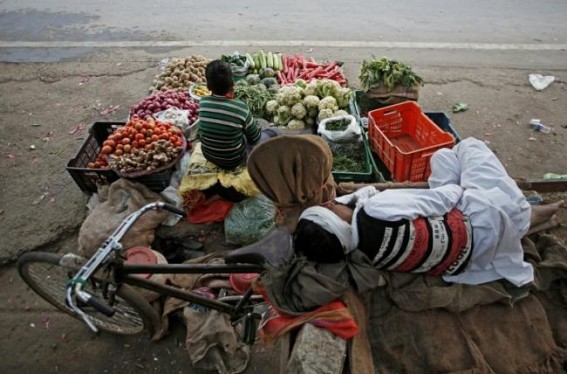TIWN

New Delhi, Dec 13 (TIWN) India's economy, it seems, has entered the stagflation phase with the key macro-economic data showing dwindling manufacturing activity as the subdued demand conditions contracted the October factory output by 3.8 per cent.
The worsening trend has also been spotted in the Consumer Price Index (CPI) as an increase in food prices lifted the November retail inflation to 5.54 per cent from 4.62 per cent in October.
However, the industrial output measured through the index of industrial production (IIP) suggests that downward production spiral has somewhat been arrested with the October output declining only 3.8 per cent against 4.3 per cent in September.
The factory output growth rate in October was nowhere near the rise of 8.4 per cent recorded in the year-ago month.
Stagflation or recession-inflation is a condition of slow economic growth and relatively high joblessness, or economic stagnation, accompanied by increasing prices, or inflation. It''s also defined as inflation and a decline in gross domestic product (GDP).
According to the IIP data, the manufacturing sector output rate contracted 2.1 per cent in October from a YoY rise of 8.2 per cent, and mining activity declined 8 per cent from a YoY growth of 7.3 per cent and the sub-index of electricity generation was 12.2 per cent lower from a rise of 10.8 per cent.
Among the six use-based classification groups, the output of primary goods, which has the highest weight of 34.04, fell by 6 per cent. Nonetheless, the output of intermediate goods, which has the second highest weight, zoomed 22.2 per cent.
While consumer non-durables output slipped 1.1 per cent, consumer durables declined 18 per cent. Output of infrastructure or construction goods decreased 9.2 per cent and capital goods'' production, 21.9 per cent.
According to the October IIP data, 18 of the 23 industry groups in the manufacturing sector showed negative growth against the year-ago month.
In terms of retail inflation, November''s reading was higher than the year-ago month, when it stood at 2.33 per cent.
As per the National Statistical Office (NSO) data, the Consumer Food Price Index (CFPI) inflated to 10.01 per cent during November from an expansion of 7.89 per cent in October and (-)2.61 per cent rise reported for the corresponding month of last year.
The CPI data assumes significance as the Reserve Bank of India (RBI) in its latest monetary policy review kept the key lending rates unchanged on account of rising retail inflation. In the monetary policy statement, the RBI predicted the CPI-based inflation to rise in the coming quarters.
The data also indicated that retail inflation has breached the medium-term target of the RBI to contain CPI inflation within 4 per cent with a band of +/- 2 per cent.
Product-wise, prices of vegetables, eggs, meat and fish pushed the retail inflation higher on the YoY basis, and the decline in ''fuel and light'' prices limited the overall food inflation.
Some economists have termed the current economic scenario as ''stagflation'' as the real interest rate now stands at (-)0.39 per cent as November CPI-based inflation came in at 5.54 per cent while repo rate is 5.15 per cent.
"Today''s inflation and growth print depicts a grim picture of stagflation. Excluding vegetables, the inflation was 2.9 per cent," Edelweiss Securities'' Economist Madhavi Arora said.
"Nonetheless, the trickle down of vegetable inflation could mean that December''s inflation print could even touch 6 per cent. Clearly, the RBI is facing a dilemma of overshooting inflation, undershooting growth and fragile fiscal situation," Arora said.
Sunil Kumar Sinha, Director, Public Finance, and Principal Economist at India Ratings & Research (Ind-Ra), said retail inflation was expected to firm up in the second half of FY20 due to base effect.
"Although unseasonal rain leading to destruction of some crops, especially onion, may have something to do with this rise in retail inflation, Ind-Ra has been highlighting that food inflation may soon turn into a cause of worry," said Sinha.
On IIP, Aditi Nayar, Principal Economist, ICRA, said, "Despite an unfavourable base effect and the disruption caused by the late withdrawal of monsoon, the pace of the YoY degrowth in industrial output narrowed in October compared with September. Nevertheless, industrial production has recorded a sobering contraction for three months in a row."
According to M. Govinda Rao, Chief Economic Advisor, Brickwork Ratings, the continued contraction in industrial output as shown by 3.8 per cent contraction in IIP is also a cause of concern.
"These indicate that the GDP growth in the industry sector in the third quarter may not be different from the second quarter. Even the high growth witnessed in public administration and defence in the second quarter may not materialise, and the economy may actually slide further," Rao said.
- Saks Global Files for Bankruptcy After Neiman Marcus Takeover
- India’s industrial growth at 3.5 pc in July signals healthy recovery: Economists
- AI to unlock $500 billion opportunity for India’s tech services: Report
- India’s credit rating upgrade to boost investors’ confidence, drive foreign capital inflows
- Centre to update WPI, IIP; announces launch of new Producer Price Index



